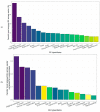Housing and Environmental Enrichment of the Domestic Ferret: A Multi-Sector Survey
- PMID: 35565492
- PMCID: PMC9102951
- DOI: 10.3390/ani12091065
Housing and Environmental Enrichment of the Domestic Ferret: A Multi-Sector Survey
Erratum in
-
Correction: Dancer et al. Housing and Environmental Enrichment of the Domestic Ferret: A Multi-Sector Survey. Animals 2022, 12, 1065.Animals (Basel). 2022 Nov 16;12(22):3160. doi: 10.3390/ani12223160. Animals (Basel). 2022. PMID: 36428457 Free PMC article.
Abstract
Ferrets (Mustela putorius furo) are kept and used in multiple sectors of society, but little is known about how they are housed and what environmental enrichment (EE) they may benefit from. We aimed to help guide caretakers about what housing and EE can be provided for ferrets. Through an online questionnaire of ferret caretakers, including pet, laboratory, zoological collection, rescue and working animal sectors internationally, we described ferret housing, opportunities for exploration, EE provision and caretaker opinions on ferrets' preferred EE types, and problematic EE. In total, 754 valid responses from 17 countries were analysed, with most (82.4%) coming from pet owners. Most ferrets were housed socially, with housing varying across sectors from single-level cages to free-range housing in a room or outdoor enclosure; pet owners mostly used multi-level cages. The most commonly reported EE included hammocks, tunnels and tactile interaction with caretakers. Respondents reported that ferrets particularly enjoyed digging substrates, tunnels, human interaction and exploration. The most frequently reported problems were that ingestion of unsuitable chew toys and rubber items could cause internal blockages, narrow tunnels could trap ferrets, and certain fabrics that could catch claws. This suggests a need for increased awareness of the risks of these EE types and for more commercially available safety-tested ferret EE. Scent trails were relatively rarely provided but were reported to be enjoyed and harmless, so we recommend that these should be provided more commonly. Our results suggest that there is scope to improve ferret housing and EE provision to benefit ferret welfare across all sectors.
Keywords: animal welfare; environmental enrichment; ferrets; housing; injury; questionnaire; veterinary.
Conflict of interest statement
The authors declare no conflict of interest. The funders had no role in the design of the study; in the collection, analyses, or interpretation of data; in the writing of the manuscript; or in the decision to publish the results.
Figures




Similar articles
-
Pet Owner Perception of Ferret Boredom and Consequences for Housing, Husbandry, and Environmental Enrichment.Animals (Basel). 2022 Nov 23;12(23):3262. doi: 10.3390/ani12233262. Animals (Basel). 2022. PMID: 36496783 Free PMC article.
-
Behavioral Evaluation of Laboratory-housed Ferrets (Mustela Putorius Furo) in Different Enclosure Sizes.J Am Assoc Lab Anim Sci. 2023 Sep 1;62(5):382-394. doi: 10.30802/AALAS-JAALAS-23-000046. Epub 2023 Sep 6. J Am Assoc Lab Anim Sci. 2023. PMID: 37673662 Free PMC article.
-
Ferret Behavior Medicine.Vet Clin North Am Exot Anim Pract. 2021 Jan;24(1):37-51. doi: 10.1016/j.cvex.2020.09.001. Vet Clin North Am Exot Anim Pract. 2021. PMID: 33189255 Review.
-
Behavior of Mustela putorius furo (the domestic ferret).Vet Clin North Am Exot Anim Pract. 2001 Sep;4(3):697-712. doi: 10.1016/s1094-9194(17)30032-4. Vet Clin North Am Exot Anim Pract. 2001. PMID: 11601109 Review.
-
Characterization and Description of the Fecal Microbiomes of Pet Domestic Ferrets (Mustela putorius furo) Living in Homes.Animals (Basel). 2023 Oct 29;13(21):3354. doi: 10.3390/ani13213354. Animals (Basel). 2023. PMID: 37958109 Free PMC article.
Cited by
-
Seroprevalence of anti-SARS-CoV-2 antibodies in household domestic ferrets (Mustela putorius furo) in Spain, 2019-2023.Vet Res Commun. 2024 Feb;48(1):533-540. doi: 10.1007/s11259-023-10190-2. Epub 2023 Aug 7. Vet Res Commun. 2024. PMID: 37548874 Free PMC article.
-
Pet Owner Perception of Ferret Boredom and Consequences for Housing, Husbandry, and Environmental Enrichment.Animals (Basel). 2022 Nov 23;12(23):3262. doi: 10.3390/ani12233262. Animals (Basel). 2022. PMID: 36496783 Free PMC article.
-
Correction: Dancer et al. Housing and Environmental Enrichment of the Domestic Ferret: A Multi-Sector Survey. Animals 2022, 12, 1065.Animals (Basel). 2022 Nov 16;12(22):3160. doi: 10.3390/ani12223160. Animals (Basel). 2022. PMID: 36428457 Free PMC article.
-
No indication for SARS-CoV-2 transmission to pet ferrets, in five cities in Poland, 2021 - antibody testing among ferrets living with owners infected with SARS-CoV-2 or free of infection.Acta Vet Scand. 2023 Feb 28;65(1):9. doi: 10.1186/s13028-023-00672-3. Acta Vet Scand. 2023. PMID: 36855124 Free PMC article.
-
Review of the Effects of Enclosure Complexity and Design on the Behaviour and Physiology of Zoo Animals.Animals (Basel). 2023 Apr 7;13(8):1277. doi: 10.3390/ani13081277. Animals (Basel). 2023. PMID: 37106840 Free PMC article. Review.
References
-
- Newberry R.C. Environmental enrichment: Increasing the biological relevance of captive environments. Appl. Anim. Behav. Sci. 1995;44:229–243. doi: 10.1016/0168-1591(95)00616-Z. - DOI
-
- Shepherdson D. Tracing the Path of Environmental Enrichment in Zoos. In: Shepherdson D., Mellen J., Hutchins M., editors. Second Nature: Environmental Enrichment for Captive Animals. Smithsonian Institution Press; Washington, DC, USA: 1998. pp. 1–12.
-
- Wells D.L. Sensory stimulation as environmental enrichment for captive animals: A review. Appl. Anim. Behav. Sci. 2009;118:1–11. doi: 10.1016/j.applanim.2009.01.002. - DOI
-
- Hahn N.E., Lau D., Eckert K., Markowitz H. Comparative Medicine Environmental Enrichment-Related Injury in a Macaque (Macaca fascicularis): Intestinal Linear Foreign Body. Comp. Med. 2000;50:556. - PubMed
Grants and funding
LinkOut - more resources
Full Text Sources

